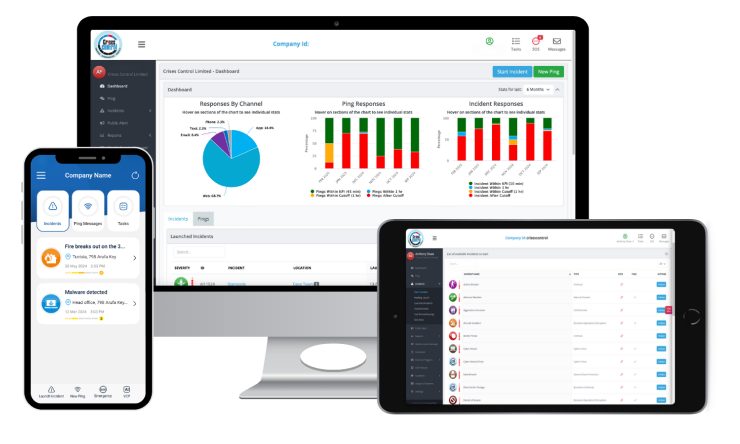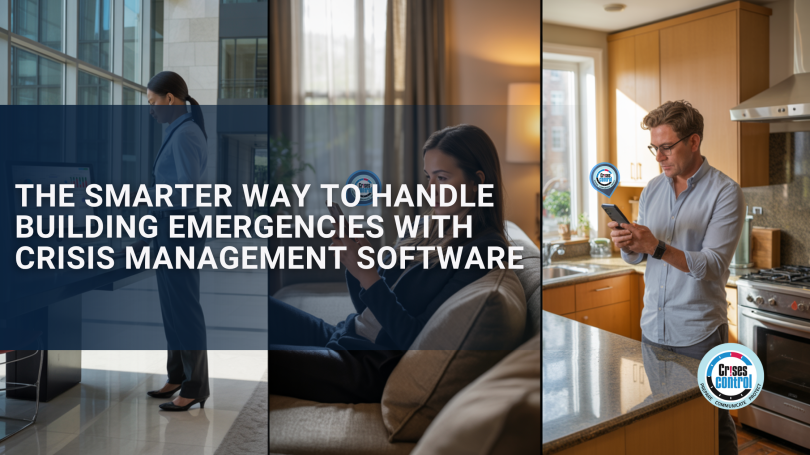Written by Anneri Fourie | Crises Control Executive
Why Property Managers Need a Smarter Way to Handle Crises
Imagine managing a large apartment block or commercial complex when an alarm goes off. You’re trying to reach security, tenants are calling for updates, and maintenance needs instructions. Minutes feel long, communication gets messy, and information spreads unevenly.
For many property management teams, this is the daily challenge. Fires, flooding, gas leaks, lift failures, or even false alarms can disrupt operations, cause confusion, and damage trust. What makes this even harder is that most buildings rely on manual processes or disconnected tools to manage these events.
This is where crisis management software can transform how incidents are handled. A platform like Crises Control gives property teams the ability to send alerts instantly, coordinate tasks, and track compliance from one central system. It replaces panic with structure, allowing teams to act faster, communicate clearly, and keep tenants safe.
The Growing Challenge of Incident Management in Real Estate
Property managers juggle a mix of responsibilities that go far beyond maintenance. They deal with tenants, contractors, facilities, and local authorities, all while ensuring every site meets safety and compliance requirements.
Common incidents they face include:
- Fire alarms or smoke events
- Power or water outages
- Security breaches or vandalism
- Flooding from broken pipes or blocked drains
- Health and safety incidents involving staff or tenants
Each of these situations requires a fast, coordinated response. Relying on phone calls or scattered email chains can delay action and create confusion. A modern incident management software platform changes that by giving managers one place to plan, communicate, and monitor everything as it happens.
1. Coordinating Alerts and Responses in Real Time
When an incident occurs, quick and clear communication makes all the difference. Crisis management software allows property management teams to send real-time incident alerts to staff, tenants, and emergency services in seconds.
Take the example of a large property group that uses Crises Control. Each Wednesday, they test their alert system by sending a scheduled fire drill notification to all tenants and staff. This routine test has now evolved into a full emergency communication framework covering different scenarios like theft, bomb threats, and building evacuations.
When an alert goes out, it includes pre-set instructions based on the incident type. Everyone receives the same verified information at the same time, reducing confusion and improving response times.
If the incident escalates, property managers can update messages instantly, share safety information, and track who has responded or acknowledged the alert.
2. Communicating Clearly with Tenants During Emergencies
During an emergency, tenants want reliable information fast. If updates are unclear or inconsistent, panic spreads quickly. A lack of communication can harm a property’s reputation and make tenants feel unsafe.
With Crises Control’s mass notification software, messages can be sent to everyone affected in seconds through multiple channels such as SMS, mobile notifications, email, Microsoft Teams and voice calls. Each alert is clear, consistent, and easy to understand.
More than that, tenants can respond to confirm they are safe or ask for help. This two-way communication allows property managers to keep track of who has received updates and who still needs assistance.
For example, when one commercial property group experienced a regional power outage, they used Crises Control to update tenants within minutes. They explained the issue, shared repair timelines, and offered guidance for safety. What could have caused frustration instead built confidence because tenants were kept informed throughout the event.
3. Tracking Incidents and Meeting Compliance Requirements
Real estate companies must meet strict safety and regulatory standards. Whether it’s the UK’s Fire Safety Order, the EU’s Occupational Safety Directive, or North America’s OSHA and NFPA codes, every incident must be recorded, reviewed, and reported correctly.
Doing this manually can take hours. Information might be incomplete or stored across multiple systems. Regulatory compliance incident tracking in Crises Control solves this by automatically recording every notification, action, and response.
Each incident becomes a complete digital record that can be used for audits, insurance claims, or safety reviews. Managers can see who was notified, when they responded, and what steps were taken to resolve the situation.
In one case, a property operator managing several mixed-use sites used Crises Control to document a flooding incident caused by a burst water pipe. Within minutes, the system logged all communications, tracked maintenance activity, and generated a full report for internal and regulatory review.
4. Streamlining Coordination Across Multiple Sites
For organisations managing multiple buildings, coordination becomes even more complex. Different teams, contractors, and site conditions mean that information can get lost between locations.
A crisis management platform like Crises Control connects every site under one system. Facility managers can assign tasks, monitor responses, and track progress from a single dashboard. Each building can follow the same framework while allowing for local customisation.
During a severe weather warning, a regional property group used Crises Control to coordinate across five separate buildings. Each facilities team received automated instructions to check drains, secure entrances, and confirm tenant safety. Within minutes, management had full visibility across all sites and could track which actions had been completed.
This kind of clarity helps organisations not only respond faster but also learn from each incident, using data to improve their future preparedness.
5. Building a Culture of Safety and Preparedness
Technology supports crisis response, but the real strength comes from a culture of readiness. Property management teams that practise their responses perform better during real incidents.
Crises Control makes it easy to plan and record fire drills, evacuation exercises, and safety inspections. Notifications are sent automatically, attendance is tracked, and post-drill reports help identify what went well and where improvements are needed.
Tenants and staff who are familiar with procedures are more likely to stay calm during real emergencies. Regular drills also demonstrate a company’s commitment to safety, which can enhance reputation and tenant confidence.
Why Real Estate Teams Choose Crises Control
Crises Control brings together incident management software, mass notifications, and compliance tracking into one platform that adapts to the needs of property managers. It’s suitable for both small property portfolios and large, multi-site organisations.
Key benefits include:
- Fast alerts through multiple communication channels
- A single control hub for all incidents
- Automated reporting for compliance and audits
- Two-way communication for staff and tenants
- Scalability across sites and teams
By integrating seamlessly with existing property management systems, Crises Control helps organisations move from reacting to problems to managing them proactively. The result is less downtime, safer environments, and stronger tenant relationships.
Getting Started with Digital Incident Management
The first step in improving crisis response is understanding your current process. Ask yourself:
- What incidents occur most often in your properties?
- Who needs to be informed when they happen?
- How quickly can you reach everyone who needs to know?
- What evidence can you provide for audits or compliance checks?
Once you have a clear picture, Crises Control can be tailored to your workflows. Start with one area such as fire alerts or maintenance notifications, then expand as your team gains confidence. Most property managers find that introducing structured communication quickly improves response times and reduces stress across the organisation.
What Property Teams Are Achieving with Crises Control
Property companies using Crises Control have seen measurable improvements in both operations and tenant relations. Some reported:
- 50% faster response times during emergencies
- Clearer communication between departments and contractors
- Higher tenant satisfaction due to transparent updates
- Better audit outcomes with complete digital records
These improvements go beyond technology; they reflect a shift toward proactive management and accountability. When property teams know they can depend on reliable tools, they focus more on prevention and less on crisis recovery.
Take Control of Your Property Incidents
Incidents in property management are inevitable, but confusion and disruption don’t have to be. When communication is fast and structured, tenants stay informed, staff stay organised, and compliance requirements are met without stress.
Crises Control gives property management teams the confidence to act quickly and the tools to keep everyone safe and informed. Whether you manage one building or many, the system adapts to your needs and grows with your organisation.
Contact us today for a free demo to see how Crises Control can help your team handle incidents more effectively, improve tenant safety, and maintain compliance across every property you manage.
Request a FREE Demo

